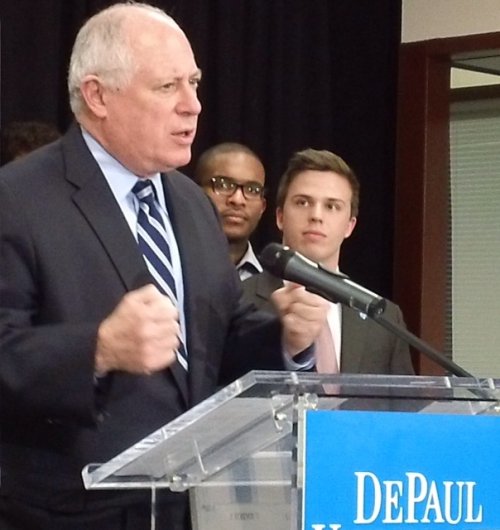By Sarah J. Wotaszak and Jocelynn Carrillo
As now-President-elect Trump’s electoral college vote crept closer to 270 with shocking brevity while Hillary Clinton’s total stagnated dozens of digits below the magic number, the world watched the remarkable upset in an unprecedentedly visceral way.

In the days following the election, passionate anti-Trump posts on social media and protests in the Loop showed that, overwhelmingly, Chicago’s students were angry, disappointed, scared, but above all, energized about civic engagement.
At the University of Illinois at Chicago (UIC), student organizations and individual activists on campus organized multiple events relating to the election and other current political issues, such as the North Dakota Access Pipeline protests and a dialogue on immigration policies in the U.S.
On November 15, students across campus left their classes at noon to meet in the Quad, chanting, “Hey-hey, ho-ho, Donald Trump has got to go!” and taking turns speaking about their reactions to his imminent presidency.
The university’s Latino Cultural Center (LCC) designated their offices on campus as a safe space for students to meet and discuss their anxieties about the President-elect. The offices focus on efforts that celebrate the university’s Latino population and help empower undocumented students through support of the Student ACCESS Bill, which would allow those students to apply for scholarships.
“A lot of students are worried about what this will mean for them and their families if they’re undocumented,” said Lena Reynolds, the public engagement coordinator at the LCC.

While there was a palpable feeling of apprehension towards the Trump’s transition into the White House, students got together and created posters that were less focused on anti-Trump sentiment, instead placing the emphasis on their dedication to empower marginalized communities, reading, “Undocumented, Unafraid, Unapologetic,” and “I’m With Them: Women, Immigrants, Blacks, Latinos, Muslims, the Disabled, LGBT.” A group poster allowed students to express their feelings about diversity, ACCESS, and feeling unity in the country after the divisive election season.
Public, on-campus meetings entitled, “The Trump Presidency: What It Is And How To Fight It” and “Alleviate Isolation Through Participation: A Post-Election Healing Activity” were held, offering students dialogue-centric alternatives to protesting.
During Trump’s campaign, he particularly targeted the nation’s undocumented population. Many individuals with undocumented status have sought protection through Consideration of Deferred Action for Childhood Arrivals (DACA), which is granted for two years and eligible for renewal, a measure that Trump has threatened to revoke.
“I have DACA. It would suck if Trump did repeal it. Just thinking about it makes me mad,” said Dania Garcia, an undocumented resident who has lived in Chicago since age 6. After having spent two semesters at Truman College, Garcia was unable to matriculate due to the unavailability of financial aid for undocumented students.
“I would not be able to work where I work now if that were to happen or even get a decent paying position. I feel hopeless because there is nothing I can do,” she said.
Andreas E. Feldmann, an associate professor in the Latin American and Latino Studies program at UIC, said: “[Trump’s] rhetoric ferments this vitriolic attitude, and its fuels fear in many people… and it emboldens other people.”
Despite his deeply emotional response to the results, Feldman said he refrained from discussing the topic within his undergraduate classrooms in the days following the election.
“It’s very likely that many of them voted for Trump, and I didn’t want to transform my classroom … So, I just didn’t raise the matter,” Feldmann said, touching on the polarization that prevents civil and productive debate across party lines.

- Post-election event poster. By Sarah Wotaszak
As was illustrated by the two major-party candidates themselves, it has become a rarity to engage in a political discussion in which a variety of ideologies are honestly and constructively represented. There are, however, professors on UIC’s campus who have paid close attention to UIC students’ vocalization and mobilization of their disapproval of Trump’s policies.
Said Dick Simpson, a professor in the Political Science department at UIC: “Students were mostly upset, there’s a large number of students who are immigrants and some are undocumented…Some other students, who are more conservative, were pleased.”
Attempts to contact student Republican organizations and vocal Trump supporters were unsuccessful.
“I think on college campuses, it’ll be much like it was in the ‘60s or ‘70s,” Simpson said, noting the similarities in student reactions towards the Johnson and Nixon administrations and their policies towards the Civil Rights Era, Vietnam War, women’s rights, and drug usage.

Said Andie Celerio, the assistant director of the Women’s Leadership and Resource Center on UIC’s campus: “I am still suffering from the election, it feels like an open wound right now.
Celerio’s sobering revelation is indicative of the still largely painful repercussions of a campaign that attacked a myriad of groups on a variety of fronts in deeply personal ways—women in particular.
“I know I don’t sound very hopeful, but that is where I am right now. There has been an increase in hate crimes. His supporters are emboldened by his words,” Celerio said, addressing the unsettling events that have characterized the Trump transition, such as the spike in hate crimes and the appointment of an alt-right senior advisor to the President-elect’s team.
For many students like Garcia, living with their undocumented status has become an even larger burden as Trump’s positions alternate between various extremes. In spite of these grim possibilities, the multiculturalism of her city offers a fortress within a nation that seeks to label and exile her from the home that she’s known since childhood.
“Chicago is so diverse and that’s what makes it a sanctuary city,” she said. “Trump can’t change that.”








